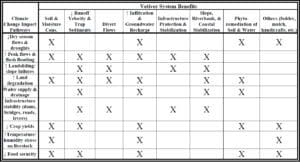This article is the first in what will be an occasional series of articles on the Vetiver System for community-led, climate change adaptation. Subsequent articles will try and focus more on specific challenges faced by communities, and successful examples and experiences that well illustrate how and why the VS “toolkit” has proven a useful option for end users and communities in search of solutions.
Why is this important and what motivates this discussion?

Unfortunately, we are all too well aware of the answers to these questions. Simply put, despite all evidence and concern about GHG emissions driving catastrophic climate change, the global emissions just keep going up and we are not doing anywhere near enough to assist those communities on the frontlines of climate change to adapt. The IPCC’s Climate Change 2022 report confirms this: Despite progress, adaptation gaps exist between current levels of adaptation and levels needed to respond to impacts and reduce climate risks (high confidence). Most observed adaptation is fragmented, small in scale…and focused more on planning rather than implementation (high confidence). Observed adaptation is unequally distributed across regions (high confidence)…[with] widening disparities between the estimated costs of adaptation and documented finance allocated to adaptation (high confidence). The largest adaptation gaps exist among lower income population groups (high confidence). At current rates of adaptation planning and implementation the adaptation gap will continue to grow (high confidence).”
In short, government and donor-dependent support for climate change adaptation suffers from too little financing, and too little on-the-ground action. It is just not credible that formal, “planned adaptation” – dependent as it is on public policy/planning/budgets, capacity, and political will – can effectively reach the most vulnerable and threatened rural communities of smallholders dependent upon agriculture (especially rainfed agriculture) and their natural resources for their livelihoods and long-term survival.
If this is the reality for poor rural communities (and it is), what are the options? One of the most obvious options is to empower communities with tools that are practical, affordable, and proven effective, as well as with the knowledge and capacity to apply and manage these themselves. A recent study that looked at hundreds of articles and major adaptation support programs and found that individuals and households engaged in smallholder agriculture and/or pastoralism were already taking the lead in seeking and applying solutions. This type of locally-led adaptation – sometimes referred to as autonomous adaptation – accounted for two out of every three concrete actions being taken to adapt to increasingly common, extreme weather events and changing weather patterns. The study also found that the effectiveness of these local adaptation efforts was constrained by “soft limits”, such as a lack of focus on: implementation and building communities’ capacity; on providing knowledge and information; access to capital to pay the costs associated with adaptation; and bureaucratized approaches prioritizing “governmental actors who are meant to act on behalf of vulnerable populations”.
This is where the Vetiver System comes in with its wide range of proven, cost-effective applications that, taken together, provide a toolkit that individuals and communities can manage and apply to enhance their resilience and climate change adaptation capacity. The table below provides examples of VS applications that are relevant for communities’ struggling to manage and mitigate the risks they face due to climate change. The VS toolkit offers communities a menu of some thirty different eco-engineering applications for making agriculture climate smart; bioengineering/green infrastructure to stabilize/protect productive infrastructure and lands; phytoremediation of contaminated lands and waters; natural disaster prevention/risk mitigation; and others to enhance livelihoods (e.g., handicrafts, roofing thatch, essential oil, medicinals, carbon sequestration).

Further demonstration of the importance of getting the VS toolkit into communities’ hands (along with the training and assistance needed to apply it properly) is found in another chapter of the IPCC’s Climate Change 2022 report: Communities and individuals play the largest role in governance of adaptations to farming and fishery practices and ecosystem-based adaptations (medium confidence). Informal or individual-led decision-making is more common in food security and livelihood related adaptations… [and] People who have experienced climate shocks are more likely to take on informal adaptation measures, and in places where people are more exposed to extreme events, autonomous adaptation is more common (high confidence). VS is now found in over one hundred countries because people in search of a solution to a problem learned about Vetiver Grass, tried it, and found that it worked. There are millions of communities in the Global South that are experiencing climate shocks and extreme events that are in search of a solution. Let’s get the VS toolkit into their hands.